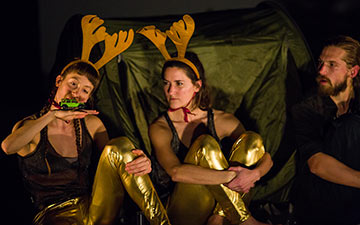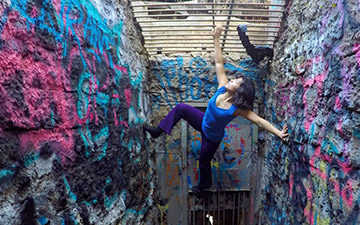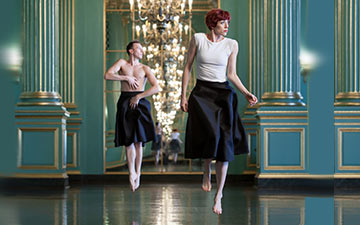
© Maria Falconer. (Click image for larger version)
Scottish Dance Theatre presents Joan Clevillé
Antigone, Interrupted
★★★★✰
London, The Place
3 March 2020
www.scottishdancetheatre.com
www.theplace.org.uk
More years ago than I care to remember, I had a peripheral involvement in staging Jean Racine’s Andromaque at the Edinburgh Fringe Festival. For the best part of five acts, this interpretation of Euripides’ tragedy played out straight until dead bodies littered the stage, at which point the actor playing Pyrrhus stood up and said something like “it was only a scratch” and for the final five minutes, the tragedy turned into a Pythonesque farce! A Scottish schoolteacher bringing her A level students to see what she had assumed was the pukka play declared that Racine would be turning in his grave and demanded the school’s money back!
Sitting in an intimate circle of chairs on the stage of The Place, this long-forgotten incident came flooding back while watching Joan Clevillé’s Antigone, Interrupted. Any schoolteachers bringing their charges to see Sophocles’ tragedy, currently on a UK tour that ends in May, would, at least, have been forewarned as to its peculiarity by the expanded title because this was, indeed, Antigone, interrupted on many levels!
One might argue that it was the excerpts from translations of Sophocles’ play about the internecine rivalries of Theban royalty that became the interruptions in this extraordinary one-woman show. Solène Weinachter is alone in the intimate circumstances of that small arena for the entire performance, during which she plays no less than five characters (both genders, mixed ages; two of whom commit suicide) as well as herself. She projects a piquant cocktail of spoken text, mime and dance with nothing to help her other than two illuminated, opposing doorways breaching the circle, a microphone, a self-operated sound machine and a couple of recorded songs.

© Maria Falconer. (Click image for larger version)
Weinachter began the piece surreptitiously; moving around and speaking to the audience (two seats were reserved for her to sit amongst us) for several minutes before abruptly morphing from Solène to Antigone. Such transitions occurred regularly, from the performer talking about watching her own sister onstage, to becoming the character of Ismene talking about her sister, Antigone. She also channelled representations of Creon, Antigone’s uncle and the new king of Thebes; and his son (and her fiancée), Haemon. With striking vocal and movement dexterity, Weinachter became the Gollum-like embodiment of Tiresias, the blind prophet who intercedes with Creon to save Antigone from a fate worse than death; and aided by the sound system her voice multiplied to represent the chorus of Theban citizens. Weinachter’s dancing is remarkably expressive, as is her voice: sensually accented by her French heritage, it has an expansive range; she references “dead bodies” in such low tones, as if a prelude to seduction. It was occasionally frustrating that when speaking without the microphone and facing away from this listener on the farthest radius of the circle, it was difficult to hear what she was saying; a more literal case of Antigone, Interrupted.
Clevillé’s direction deserves much praise. A solo show for more than an hour on such an esoteric subject is a difficult framework to sustain and Clevillé’s structure is expertly paced with quick transitions and surprising interludes. At one point, the Greek origins of the tragedy are acknowledged when Weinachter performs to the ubiquitous Zorba’s Dance (I expected plates to be thrown). Much more surprisingly, the tribute of the chorus to great women, which accompanies the living entombment of Antigone (punished by Creon for burying the body of Polynices), is represented by Glynis Johns and Hermione Baddeley singing the Sister Suffragette march, which must be a sure-fire cert to be the Pointless answer to the question of naming songs from the original Mary Poppins film!
Fresh from winning the 2019 National Dance Award for Outstanding Female Modern Performance for her portrayal of Juliet in Lost Dog’s Juliet & Romeo, Weinachter delivered another dramatic masterclass of scintillating power and versatility, never faltering with the text-heavy content (sometimes spoken when contorted into the most pliant of dance positions). Her ebullient confidence in holding the audience’s attention so raptly with nowhere to hide was intense and even more remarkable when she appeared as surprisingly bashful during deserved and sustained applause at the end. Utilising the appropriateness of a term from her first language, this really was a tour de force.

















You must be logged in to post a comment.